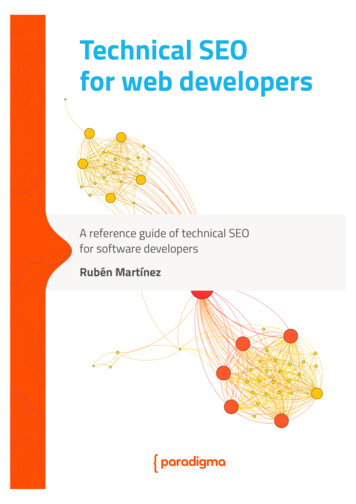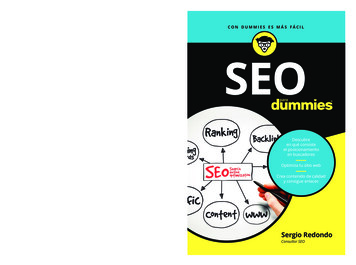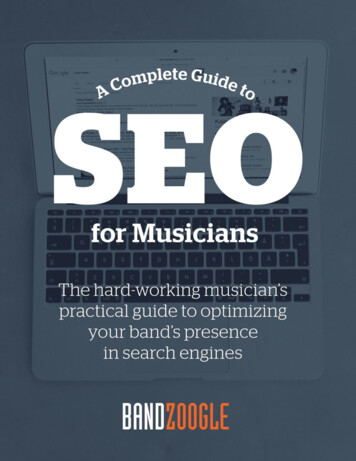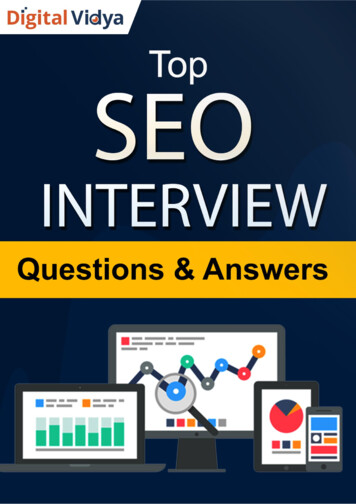
Transcription
Social Listening in PracticeSEO &Content Strategy Brandwatch.comSocial Listening in Practice/ SEO & Content Strategy 2016 Brandwatch.com 1
1.0 SEO & Content: A Lasting StrategyIt’s often easy to forget how influential and powerful today’s search engines are. Over the past two decades, wehave become increasingly reliant on Google to find answers, research ideas and guide our decisions.Search engines have no easy task – their aim is to interpret our wildly varying queries and present us with themost important and relevant resources available. Essentially, it is the search engine that determines what isvaluable information to the online world. That endeavor is enormously influential on today’s businesses.For those less convinced by this assertion, consider that over 80% of consumers research online beforepurchasing products in-store1 and that direct online sales account for 7.5% or 1,184.8 billion worth of totalUS sales.2 As that trend progresses, the role of SEO will only grow more important.Yet SEO is no easy task either. Marketers are asked to know both the relevant questions people are askingsearch engines as well as the factors search engines deem valuable. They must understand the users withoutever meeting them and the search engines without knowing the algorithm.Over the past decade, many experts have targeted the algorithm, employing SEO strategies, such as linkbuilding schemes, to convince Google to rank their content highly. Yet because Google constantly updates theiralgorithm to combat these practices, we believe that view is mostly shortsighted.Instead, businesses should seek innovative ways to provide genuine value to their audience. ConsideringGoogle as a human interpreter rather than an algorithm, they should ask how they can activate Google andtheir readers to support their content, whether that’s through backlinks, social shares, engagement or otherpromotion. To do so, businesses will need to better learn understand audiences.In this regard, social media, rich with naturally occurring opinions and feedback, proves to be a surprisinglyeffective resource for identifying how people communicate, spreading awareness around content andevaluating content’s performance. In the long run, these strategies will ensure a strong backlog of content anda high search engine rank that survives the constant onslaught of Google updates.Stefanie Bull/Agency Group Manager at Brandwatch12PricewaterhouseCoopers. Understanding how US online shoppers are reshaping the retail experience. 2012.US Census Bureau. Quarterly Retail E-Commerce Sales 4th Quarter 2015. February, 2016.Social Listening in Practice/ SEO & Content Strategy 2016 Brandwatch.com 2
Contents:1.0 SEO & Content: A Lasting Strategy 2Contents: 32.0 The Current State of SEO 43.0 The Effect of Social Shares on Ranking 54.0 Social for Content Strategy 64.1 Social for Keyword Research 64.2 Social Media Signals for Trending Content 84.3 Uncovering Content Opportunities: 94.4 Knowing the Audience 104.5 Identifying Successful Content 115.0 Amplification: Influencer Outreach 136.0 Acquiring Links for SEO 146.1 Acquiring Links on Relevant Sites 146.2 Building Links on Existing Mentions 157.0 Auditing an SEO & Content Strategy 178.0 Summary 18Thank you 19About Brandwatch 19Social Listening in Practice/ SEO & Content Strategy 2016 Brandwatch.com 3
2.0 The Current State of SEOFor well over a decade, Google’s algorithm, which manages over 60% of online searches, has essentiallydirected the course of SEO practices.3 In recent years, a few major updates to Google’s algorithm havefundamentally changed the current school of thought around SEO.In 2011, the Panda update aimed to lower the ranking of sites with ‘low quality’, ‘thin’ and ‘duplicate’ content,while promoting the ranking of ‘high quality’ sites. In doing so, Google sent a clear message that quality contentcould not be ignored or manipulated. Of course, the update lead to a quick rise in content marketing as anSEO tactic.The second major update occurred in April, 2012. The Penguin update punished sites that attempted toartificially manipulate Google’s search ranking through link building schemes. The update stymied sites thatwere deemed to have built artificial links, a previously successful strategy. The release ensured that link wouldneed to be earned, not bought.The 2013 Hummingbird release completely overhauled the entire Google algorithm, providing faster and moreprecise query results based on semantic search. Emphasizing user intent over individual search terms, theupdate forced the SEO industry to focus on the subject of content rather than keywords.Of course, Google also introduces 500-600 updates a year alongside these major ones.4 However the cycle isa familiar one: Google aims to return the most relevant, high quality content based on user’s intent, a few sitesuncover ways to temporarily “game” the algorithm, and Google eventually identifies the scheme and adjuststheir algorithm accordingly.For websites, undergoing a sharp decline in search traffic can be devastating. The key takeaway from this cycleis that in the long run, focusing on quality content that is relevant to the audience is increasingly important asGoogle’s algorithm improves.In summary, an effective SEO strategy will now include: A strong understanding of your audience, including how they search, what content they share and what theytalk about. The creation of high quality content that will be shared by your audience and gain natural links.34Brand building techniques such as influencer marketing and PR to increase your brand awareness andamplify your content marketing.comScore. April, 2015, Search Engine Rankings. April, 2015.Moz. Google Algorithm Change History. https://moz.com/google-algorithm-change Social Listening in Practice/ SEO & Content Strategy 2016 Brandwatch.com 4
3.0 The Effect of Social Shareson RankingBefore the days of Twitter and Facebook, the world of organic search focused primarily around keywordoptimization and link building. While these factors are still important, there are now over 200 factors thataffect rankings.As social media adoption continues to grow, search engines have adapted their algorithms to take data fromsocial sites into account when deciding where to rank a website. There is some debate in the SEO industry as tohow much of a factor these signals are.In 2010, Matt Cutts confirmed in a video that Google takes Social Signals into account – this means thatretweets, likes and shares are likely to work toward your SEO strategy.5 Then, in a 2014 video he qualified thatfurther, stating that some pages are inaccessible to Google’s crawlers, and that the algorithm is unable toweight links depending on number of followers or likes.6There are several tests and studies that show a link between social signals and improved rankings.7 Theunderlying principle is that the more exposure content gets, the more opportunities there will be to attract linksfrom both social and non-social sites.This reinforces the need for great content on your site - useful content is more likely to be shared by socialusers, generating those Likes and RTs, and further driving traffic and rankings.And of course, even if Twitter, Facebook or Instagram don’t drive large volumes of traffic or sales for yourbusiness, you should still be leveraging these networks to generate conversation about your brand, productor service.567Matt Cutts. Does Google use data from social sites in ranking? YouTube. 2010.Matt Cutts. Are pages from social media sites ranked differently? YouTube. 2014.QuickSprout. How Social Signals Impact Search Engine Rankings. 2014.Social Listening in Practice/ SEO & Content Strategy 2016 Brandwatch.com 5
4.0 Social for Content Strategy4.1 Social for Keyword ResearchWhen Google moved to secure search in 2011, publishers lost the ability to see the search terms used to reachtheir websites. As such, most analytics reports will now display “not provided” as the leading keyword.This presented a new challenge for content creators and SEO experts. Being unable to know which keywordsdrive traffic to a site makes it difficult to expand the content into relevant, related terms which will increasesearch traffic.Consequently a lack of useful keyword analytics is one of the major roadblocks to an effective SEO strategy –social keywords may provide the solution.Listening to online conversations about your brand, products and services can help you to understand howconsumers are talking about your niche online and therefore what they might be searching for to discoveryour products.The beauty of using a listening platform is that you’re able to uncover natural conversations about productsor brands in real-time. That is, how people discuss your products online, the specific language they use, thequestions they are asking and the key conversation drivers. This can all help to inform keyword selection, bothfor organic search, PPC, and content planning.Social Listening in Practice/ SEO & Content Strategy 2016 Brandwatch.com 6
Now compare this to social data gathered in Brandwatch. We created a simple query for “fake tan” or “self tan”mentions. A quick glance at a topics cloud immediately shows some opportunities for search:In Brandwatch’s topic cloud, the smell associated with fake tanning products is a significant conversationdriver, with users having differing views on the topic:wearing fake tanPutting fake tansmell of fake tanSt TropezBBUKInstant Self TanFake Bakeput fake tanSocial Listening in Practice/ SEO & Content Strategywear fake tanskin diseasekprs Flbiz 2016 Brandwatch.com 7
Thanks to a quick search on social, we now know this is a busy topic that users are already naturally interestedin and discussing online. It would make sense to create some content around this topic using relevant long-tailkeywords, and to also consider promoting that content via PPC advertising as well as through social channels.4.2 Social Media Signals for Trending ContentOne effective strategy for earning search traffic is to produce content around trending topics. Google FellowAmit Singhal describes how specific Google searches will strongly favor content that is fresh.8 Recent hot topics or events: ”occupy oakland protest” “the dress”Regularly recurring events: “NBA scores” “dancing with the stars” “exxon earnings”Frequently updated content: “best slr cameras” “subaru impreza reviews”Listening to real-time conversations around a specific industry, product or topic allows businesses to reactquickly to emerging trends with relevant fresh content.For trend alerts, social media intelligence is far more responsive than current keyword tools, which are slow toupdate – this makes social intelligence a powerful tool for trend hijacking and long-tail keyword identification.This approach means your content strategy can join and even lead the trending conversation, not follow thetrends after they happen. The amount of searches undertaken at the start of a trend will provide a real boost ifyou can publish content in a timely matter.8Moz. Freshness Factor: 10 Illustrations on How Fresh Content Can Influence Rankings. 2011.Social Listening in Practice/ SEO & Content Strategy 2016 Brandwatch.com 8
4.3 Uncovering Content Opportunities:Social media intelligence can provide valuable insight on what ideas or themes are currently important withinany conversation. For content writers, that means a better understanding of what content will resonate with theaudiences of any niche business.Using our self tanning Query as an example, several recurring themes emerge: Holidays/IbizaDifficulty in applying self tan to your backThe smell of self tanTanning mishapsThe effort required to apply self tanThe ability of a self tan to help you feel good about yourself, feel happy, improve your moodGetting ready for a night outHow to effectively remove self tanThe idea of “needing to” use self tanPeople discussing self tan in association with getting married and their wedding dayIn order to analyze this in more detail, we have created a Category for each different type of conversation.This enables us to chart these conversations out over time.On the next page we can see this broken out from January – July 2015:FAKE TAN CONVERSATION THEMES600MENTION YJUNEJULY EFFORT FEELING GOOD HOLIDAYS MARRIAGE/WEDDINGS MISHAPS NEEDING TO TAN NIGHT OUT REMOVAL SMELL TECHNIQUESSocial Listening in Practice/ SEO & Content Strategy 2016 Brandwatch.com 9
We can see that smell continues to be the dominant theme of discussion, but interestingly we can also see acouple of spikes in wedding/marriage-related conversation in January and April/May, with a smaller peak inmid July.Through a simple listening approach we have quickly identified an opportunity to create some targetedcontent around self-tanning for brides-to-be, along with a clear indication of when to release this contentfor best success.4.4 Knowing the Audience60%A better understanding of who the people are that discuss your brand or productsonline can provide the means to tailor content messaging to a specific audience.Social intelligence tools like Brandwatch can uncover audience insights on locality,profession, interest, and gender to help you identify the different groups within yourtotal customer base.19527 authorsFor example, an analysis of the conversation surrounding Comedy Central reveals thattheir audience is predominantly male.40%13033 authorsFurthermore, in the context of television networks in general, which is 62% female, Comedy Central is an evenmore male-centric brand online. That information may help content writers identify who their audience is.However, for brands to better understand how they’re attracting certain demographics, they’ll want tounderstand more specifically what content is resonating. The following figure reveals how much contentsurrounding three Comedy Central shows are discussed by males and females.GENDER BREAKDOWN BY 7%02040 FEMALE MALE6080100With that analysis, brands can identify not only who their audience is, but also what types of content they’reinterested in and how they can amplify their presence among certain demographic groups. Similar analyses foraudience interest, profession and location can provide even more in-depth insights.Social Listening in Practice/ SEO & Content Strategy 2016 Brandwatch.com 10
4.5 Identifying Successful ContentWhen people like, share or retweet social content, they are essentially stating that the content is valuable tothem in some way – marketers might think of these as “social votes.” In this light, it’s unsurprising that suchsocial votes would contribute to Google’s ranking.More importantly, social votes help content creators understand what is resonating best with an audience.Additionally, by examining the content created by both your brand and competitors, you can gain insight onwhat content interests your shared audience – that feedback can then inform the direction of future content.For example, within the telecommunications industry, Facebook status updates, which are usually the worstperforming type of Facebook post, actually draw the highest number of comments.FACEBOOK POST FORMAT PERFORMANCE24%25%4% IMAGE LINKLIKES: 343LIKES: 101COMMENTS: 135COMMENTS: 256SHARES: 41SHARES: 10 PHOTOLIKES: 85947% STATUS VIDEOLIKES: 476COMMENTS: 126COMMENTS: 160SHARES: 61SHARES: 71A closer analysis will reveal that the success of status updates is due to two reasons. Firstly, many brandsuse statuses to report malfunctions, which generally draws questions, complaints and other responses fromaudiences. Secondly, DirecTV frequently uses statuses as polls, which drove an average of 324.9 commentsper status.Social Listening in Practice/ SEO & Content Strategy 2016 Brandwatch.com 11
DIRECTV/February 26 at 5:02pmWho is the youngest person to win an acting Oscar?A. Anna Paquin - The Piano2. Tatum O’Neal - Paper MoonC. Patty Duke - The Miracle WorkerWatch Oscar nominated films tonight on DIRECTV CINEMA:http://goo.gl/i46qfzLIKES/REACTIONS 41These analyses can help content creators identify what types or topics of content are successful within theirspecific audience.Social Listening in Practice/ SEO & Content Strategy 2016 Brandwatch.com 12
5.0 Amplification: Influencer OutreachWhile creating excellent content is central to a successful SEO strategy, that content is useless unless it attractsreaders. Of course, there is a catch-22, as a high Google ranking is key to attracting readers.One effective way of breaking into new audiences is through influencer outreach. Social intelligence reveals notonly what is resonating with an audience but also who is leading the conversation and generating that interest.Getting influencers to engage with your content will give it an important boost, introducing it to the influencer’swider audience. However, identifying and connecting with influencers that access a relevant audience can bedifficult for many businesses.The first step will of course be identifying relevant influencers. Social listening can uncover the influentialindividuals within a specific conversation or audience. A simple way of uncovering influencers is toexplore accounts with high follower counts or websites with high MozRank that are participating inyour industry’s conversation.For example, the figure below shows which Twitter accounts mentioning Uniqlo have the highest numberof followers.Yet discovering people who not only have a large following, but who are specifically influential within yourindustry or target audience is foundational to a successful influencer marketing campaign.As well as identifying these influencers on social media, blogs, and forums, you can listen to what they aresaying. In order to begin to build a mutually beneficial relationship, you need to show an understanding andappreciation of the individual when contacting them.In addition, listening to influencers will keep you updated on the content and topics that thought leaders aresharing and engaging with, providing further topics for content creation.Social Listening in Practice/ SEO & Content Strategy 2016 Brandwatch.com 13
6.0 Acquiring Links for SEO6.1 Acquiring Links on Relevant SitesListening to where your audience are talking will help you find new communities to promote your content to andhopefully allow you to build high quality and relevant backlinks.In the past, guest blogging was a common SEO tactic used to acquire links on external sites. In 2014 Google’sMatt Cutts revealed that the practice had become too spammy and as a consequence the practice was beingpenalized by the search engine.9As a result, many sites are reluctant to offer guest posting opportunities, and if they do agree to a post willoften insist on nofollow links. This means that SEOs have to get more creative when attempting to buildlinks. Discovering relevant sites that would naturally link to your content should be mutually beneficial forboth parties.To improve the likelihood of success, and to ensure that your content is a good fit, research of the site’s topicand audience is important. In addition, knowing more about the decision maker you are going to contact is alsogood practice.When you reach out to a site, this research will demonstrate that you have a genuine reason for contactingthem and are not sending spammy requests to numerous sites. Social listening can help you better understandthe nuances of these communities. If you have been following a community or site owner on various socialchannels, your outreach message can be tailored to highlight why you think your content is a good fit.In our self tanning example, we can see that the top site for discussion of self tan in relation to weddings is aforum called youandyourwedding.co.uk:9Matt Cutts. The decay and fall of guest blogging for SEO. 2014.Social Listening in Practice/ SEO & Content Strategy 2016 Brandwatch.com 14
A dive into the mentions shows us a really targeted group of people discussing the pros and cons of using selftan on their wedding day, even asking for brand recommendations:By doing some research on the site and the concerns of this niche group you can decide whether your contentwill be relevant and helpful. If it is, a tailored message that demonstrates the value your content and can add tothe discussion will hopefully be enough to gain trust and earn a backlink.6.2 Building Links on Existing MentionsMarketers can also gain links by identifying existing mentions in news sites, forums, and blogs and requestingthat authors backlink the mentions. Such links will immediately direct traffic from the outside website but willalso promote Google’s ranking.Recall that while Google’s updates have altered the weighting of backlinks as a ranking factor, they are still oneof the most important aspects of SEO. As has been the case since Google first rolled out Pagerank, a link froma website with high domain authority will be worth a lot more than a niche blog with a small audience, as it is asignal that a trusted website rates your content highly.Social Listening in Practice/ SEO & Content Strategy 2016 Brandwatch.com 15
In our example query for tanning brand Fake Bake, we identified a story on The Telegraph newspaper websiteabout winter tanning, which mentioned Fake Bake but did not link out to the brand’s website:By reaching out to authors and websites you can build the backlinks to your content and help improve yourrankings along, in addition to increasing referral traffic from the link.Discovering existing mentions such as this and reaching out is one of the most cost effective ways ofimproving your link profile. It is a simple process that can reap good rewards from minimal effort. A polite emailis all it takes to reach out to the author, which takes little time and no money.As the author is already aware of your brand, and considers it worthy of referencing, the request is generallyunderstood as a friendly nudge. And as they deem your brand of interest to their audience it is likely that Googlewill consider it a relevant link as well. It’s relevance means that Google understands that the link is likely to havehappened naturally. Naturally occurring links are what Google wants, rather than fake or spam links.Social Listening in Practice/ SEO & Content Strategy 2016 Brandwatch.com 16
7.0 Auditing an SEO &Content StrategyIf your efforts have succeeded, Google Analytics will of course see a rise in the amount of organic search trafficcoming to your site. Assuming your SEO strategy is multifaceted and social is just one part of the plan, it maybe difficult to completely attribute any rise in traffic to your social strategy.Increased engagement on social should lead to increased traffic from social sources, easily attributed in GoogleAnalytics. Similarly, identifying influencers and bloggers to seed your content will drive referral traffic from thosespecific sites.Using a tool like Brandwatch as well as Google Analytics means you can understand in much greater detail howwell your efforts on social have worked.You can discover which sites have linked to your content. This is then further broken down by number ofmentions, sentiment, the impact of that website (including MozRank and number of backlinks), plus the numberof monthly visitors to that site. You can also discover how many links to your website you have earned, even if alink shortener has been used.Looking at Twitter channels you can discover which Tweets have been most impactful, with retweets, replies,followers and impressions for each tweet. Facebook channels offer similar functionality, showing impact, likes,shares and comments.Combining this data with organic traffic from Google Analytics will allow you to discover the impact of yoursocial SEO strategy, and refine your methods accordingly to continually improve the results.Social Listening in Practice/ SEO & Content Strategy 2016 Brandwatch.com 17
8.0 SummaryRegardless of your business sector or the size of your organization, good SEO practice is vital to improving yourreach and visibility.Social signals, and the increased promotion available through these channels can give your SEO a vital boost,and content research can uncover new avenues that resonate with your audience.SEO Strategy Checklist: Social Signals can drive traffic and increase Google rankings Understanding your audience will help writers develop more targeted content Tracking mentions of your brand or content can help create backlink opportunitiesSocial intelligence can uncover industry-relevant conversation topics to inform content creationMonitoring conversation can power fresh content with real-time updates on trending topicsIndustry and competitor social content can reveal what topics or ideas are popular or successful withinan industryRelevant influencers can help promote content and provide a better understanding of what contentleaders shareSocial listening can help track and refine SEO and content strategiesSocial Listening in Practice/ SEO & Content Strategy 2016 Brandwatch.com 18
Thank youAbout BrandwatchBrandwatch is the world’s leading social intelligence company. Brandwatch Analytics and Vizia products fuelsmarter decision making around the world.The Brandwatch Analytics platform gathers millions of online conversations every day and provides userswith the tools to analyze them, empowering the world’s most admired brands and agencies to make insightful,data-driven business decisions. Vizia distributes visually-engaging insights to the physical places where theaction happens.The Brandwatch platform, ranked highest in customer satisfaction by G2Crowd in the Winter 2016 social mediamonitoring report, is used by over 1,200 brands and agencies, including Cisco, Whirlpool, British Airways, SonyMusic, and Dell. Brandwatch continues on its impressive business trajectory, with more than 50 percent ofrevenues now from North AmericaBrandwatch. Now you knowSocial Listening in Practice/ SEO & Content Strategy 2016 Brandwatch.com 19
Contact/Email contact@brandwatch.comWeb brandwatch.comTwitter @brandwatchTelephoneUS 1 212 229 2240UK 44 (0)1273 234290DE 49 (0)30 5683 7004-0 Brandwatch.com
2.0 The Current State of SEO For well over a decade, Google's algorithm, which manages over 60% of online searches, has essentially directed the course of SEO practices.3 In recent years, a few major updates to Google's algorithm have fundamentally changed the current school of thought around SEO.










